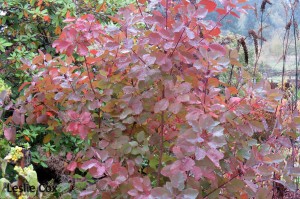Cotinus ‘Grace’
Family: Anacardiaceae
Common name: smoke bush; smoke tree; smokewood
Zone: 4 – 8
Height: 10 – 15 ft (3 – 4.5m)
Spread: 10 – 15 ft (3 – 4.5m)
Aspect: full sun; partial shade
Soil: moderately fertile; well-draining
Water: moderate
Description: Deciduous shrub with a pleasing, multi-branched, natural-forming shape. Boasts lovely round leaves that emerge light red in spring, darkening to a reddish-purple in summer before turning a brilliant orange-red in autumn. Large, open panicles of frothy pink flowers appear in early summer.
 Special Notes: A cross between Cotinus coggygria ‘Velvet Cloak’ (a seedling discovered in a nursery in the US) and Cotinus obovulatus (native to SE United States). Pleasing, natural growth form requires little pruning and then only to keep paths clear or make room for its neighbour. Deer resistant. Tends to be susceptible to verticillium wilt and powdery mildew. Allow airflow to minimize contracting these diseases. Propagation is difficult.
Special Notes: A cross between Cotinus coggygria ‘Velvet Cloak’ (a seedling discovered in a nursery in the US) and Cotinus obovulatus (native to SE United States). Pleasing, natural growth form requires little pruning and then only to keep paths clear or make room for its neighbour. Deer resistant. Tends to be susceptible to verticillium wilt and powdery mildew. Allow airflow to minimize contracting these diseases. Propagation is difficult.
In our Zone 7a garden: John planted ‘Grace’ on the south side of our pond to create some shade for the goldfish. However, we soon discovered the shrub’s height was impacting on getting past it on our way to the greenhouse or toolshed. This prompted John to coppice…cut back…the shrub to just above the soil level. Doing this annually meant the shrub’s new growth remained better behaved and did not overly impact on the path.
Full disclosure, however, because coppicing ‘Grace’ every year meant our shrub did not produce any frothy pink flowers. It was a sacrifice we endured though as we still were able to enjoy the lovely changes in its foliage as the days progressed into autumn.
Unfortunately, we were forced to remove ‘Grace’ from the garden when we had to renovate our fish pond in 2021. And that is the whole thing with a garden…change happens on a regular basis.
Great Plant Pick 2003
Posted on November 6, 2014; updated on February 5, 2025
Choisya x dewitteana ‘Aztec Pearl’
 Choisya x dewitteana ‘Aztec Pearl’
Choisya x dewitteana ‘Aztec Pearl’
(CHOY-zee-ah duh-wit-ee-AY-nuh)
Family: Rutaceae
Common name: Mexican mock orange; Mexican orange blossom
Zone: 7 – 10
Height: 8 ft (2.5m)
Spread: 8 ft (2.5m)
Aspect: full sun; partial shade
Soil: fertile; well-draining
Water: regular
Description: An evergreen, dense, rounded shrub. Aromatic, glossy, bright yellow-green leaves made up of three oblong leaflets. Clusters of fragrant, star-shaped, creamy white flowers appear in late spring. There may be a second flowering in autumn.
Special Notes: A cross between Choisya ternata and Choisya dumosa var. arizonica bred by Peter Moore of Hilliers Nurseries in 1982. This cultivar was the first hybrid in the genus and named for the French nurseryman, Dominique de Witte.
Needs some protection in Zone 7. Will tolerate seaside conditions but not direct exposure to salty winds. Prune into shape after flowering. Leaves will be more golden yellow if grown in full sun. Propagate by softwood cuttings in late spring; hardwood cuttings in autumn.
In our Zone 7a garden: Choisya x dewitteana ‘Aztec Pearl’ resides under the eave on the right corner at the front of the house. The eave provides protection when our winter temperatures dip to -12 °C (10.4 °F) and lower some years. ‘Aztec Pearl’ is also protected in that spot from the prevailing SE winds which seem to be getting increasingly stronger each year.
RHS Award of Garden Merit 1993
Posted on January 17, 2013; updated on January 15, 2025
Buddleja davidii ‘Harlequin’
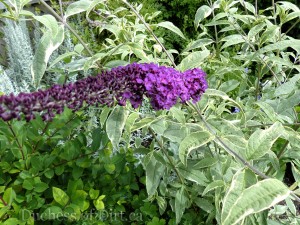 Buddleja davidii ‘Harlequin’
Buddleja davidii ‘Harlequin’
(bud-LEE-ah dah-VID-ee-ee)
syn. Buddleia davidii ‘Harlequin’
Family: Scrophulariaceae
Common name: ‘Harlequin’ butterfly bush; summer lilac
Zone: 6 – 9
Height: 5-7 ft (1.5-2.0m)
Spread: 3-5 ft (0.9-1.5m)
Aspect: full sun; partial shade
Soil: average; well-draining
Water: moderate
Description: A deciduous shrub with a bushy, arching branch, vase-shaped growth habit. Lanceolate light green leaves are edged with creamy soft butter-yellow margins in spring that lighten to creamy white in summer. Masses of cylindrical panicles of reddish-purple fragrant flowers appear in early summer through to autumn.
Special Notes: ‘Harlequin’ is a sport of B. d. ‘Royal Red’. Large buddleja should be pruned annually as their branches tend to split with age. Prune shrub back to 2 ft (60 cm) in late winter. Do not prune hard in autumn as this may reduce its winter hardiness. Flowers on current year’s growth. Attracts bees and butterflies. Drought tolerant. Deer reportedly only feed on buddleja as a last resort. Propagation by softwood cuttings in summer.
Posted on April 19, 2013; updated on September 23, 2024
Aronia melanocarpa
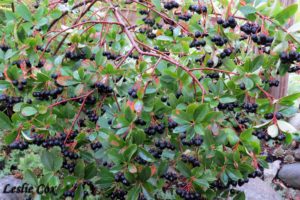 Aronia melanocarpa Family: Rosaceae
Aronia melanocarpa Family: Rosaceae
(ah-ROE-nee-ah mel-an-oh-KAR-pah)
Common name: black chokeberries
Zone: 3 – 8
Height: 3-6 ft (0.9-1.8 m)
Spread: 6-10 ft (1.8-3 m)
Aspect: full sun; partial shade
Soil: average; well-draining
Water: moderate
Description: A medium-sized, deciduous shrub with a fairly low, spreading growth habit. The dark green, glossy leaves are obovate in shape with a rounded tip. Colour turns a wonderful purplish-red in autumn. Clusters of 5-petaled white flowers open for a short bloom period in May, followed by dark, round, edible berries in autumn. Berries first appear dark purple, maturing to black when fully ripe.
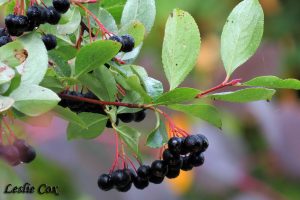 Special Notes: Native to North America, primarily the area around the Great Lakes in Canada and the United States. Once used by the native peoples as a meat preservative in preparing pemmican. More recently, it has been discovered aronia berries have wonderful health benefits. Besides being saturated with natural anti-fungal, anti-bacterial, and anti-diabetic qualities, the berries are rich in anthocyanins and polyphenols…which protect the urinary tract, stimulate the circulation and strengthen the heart. Ongoing studies are showing black chokeberries also contain compounds helpful in fighting certain cancers and heart disease. There is also ongoing research on its benefits for memory loss and cognitive deterioration.
Special Notes: Native to North America, primarily the area around the Great Lakes in Canada and the United States. Once used by the native peoples as a meat preservative in preparing pemmican. More recently, it has been discovered aronia berries have wonderful health benefits. Besides being saturated with natural anti-fungal, anti-bacterial, and anti-diabetic qualities, the berries are rich in anthocyanins and polyphenols…which protect the urinary tract, stimulate the circulation and strengthen the heart. Ongoing studies are showing black chokeberries also contain compounds helpful in fighting certain cancers and heart disease. There is also ongoing research on its benefits for memory loss and cognitive deterioration.
Aronia melanocarpa has few insect or disease problems, although there is some susceptibility to leaf spots…merely a cosmetic problem. Twig and/or fruit blight could also be a slight problem.
 In our Zone 7a garden: Our Aronia shrub sits at the corner of the raised bed by the steps leading up to the pond…and beyond. It was relocated to this location in 2013 after being deemed unsuitable in the first spot John placed it when the plant was purchased in 2011. I only mention this so you have some understanding its current size of about 3 feet (0.9 m) tall and roughly 5 feet (1.5 m) wide may not be its final stature. However, this shrub does lend itself to being kept in check through some judicious pruning.
In our Zone 7a garden: Our Aronia shrub sits at the corner of the raised bed by the steps leading up to the pond…and beyond. It was relocated to this location in 2013 after being deemed unsuitable in the first spot John placed it when the plant was purchased in 2011. I only mention this so you have some understanding its current size of about 3 feet (0.9 m) tall and roughly 5 feet (1.5 m) wide may not be its final stature. However, this shrub does lend itself to being kept in check through some judicious pruning.
This past fall (2016), I managed to beat the birds to the berries. (Warning: you must be quick! As soon as the birds…mainly robins in our garden…pronounce the berries are finally ripe enough to eat, the entire shrub is harvested in two days…three at the very outside.) I froze all of this year’s harvest in batches on a waxpaper-lined cookie sheet and transferred the frozen berries into freezer bags for later use in smoothies. Delicious.
Posted on December 17, 2016; updated on August 6, 2024
Amelanchier x grandiflora ‘Princess Diana’
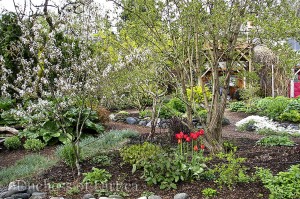 Amelanchier x grandiflora ‘Princess Diana’
Amelanchier x grandiflora ‘Princess Diana’
(am-uh-LAN-kee-er x gran-dih-FLOR-ah)
Syn. Amelanchier laevis ‘Princess Diana’; Amelanchier ‘Princess Diana’
Family: Rosaceae
Common name: apple serviceberry; hybrid serviceberry; serviceberry
Zone: 4 – 9
Height: 15 ft (4.5 m)
Spread: 12-15 ft (3.6-4.5 m)
Aspect: full sun; partial shade
Soil: moist; acidic; well-draining
Water: regular
 Description: Reasonably small, deciduous, understory tree with finely-toothed, 3 inch (7.6 cm) long, oval-lanceolate leaves, emerging with bronze tints in spring, gradually changing to dark green though summer before changing a brilliant red to orange-red in fall. Showy white flowers appear in April followed by edible 3/8-inch (9.5 mm) diameter edible berries which are a deep red-purple when fully ripe in late June through early July.
Description: Reasonably small, deciduous, understory tree with finely-toothed, 3 inch (7.6 cm) long, oval-lanceolate leaves, emerging with bronze tints in spring, gradually changing to dark green though summer before changing a brilliant red to orange-red in fall. Showy white flowers appear in April followed by edible 3/8-inch (9.5 mm) diameter edible berries which are a deep red-purple when fully ripe in late June through early July.
Special Notes: Amelanchier spp. are native to North America. Amelanchier x grandiflora is a hybrid cross between A. arborea (downy serviceberry) and A. laevis (Allegheny serviceberry), two species of North American serviceberries.
‘Princess Diana’, one of several named cultivars in this Amelanchier species, is known for its abundant floral display of white flowers, wide canopy and its vibrant fall colour. It was discovered in the mid-1980s in a garden in Elm Grove, Wisconsin. A U.S. Plant Patent PP6,041 was issued on October 20, 1987.
Pests and Diseases: There are no serious insect or disease problems, although amelanchiers can occasionally have problems with powdery mildew, leaf spot, rust, fire blight and canker. So far, our tree has not experienced any problems whatsoever. (Touch wood.)
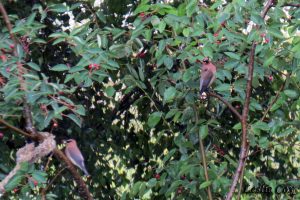 In our Zone 7a garden: We absolutely adore this small tree in the back garden! It resides in the shadow of the ancient transparent apple tree and is further shaded by the 12 ft (3.6 m) tall cedar hedge. Still, the flowers appear in April and there always seems to be enough bees around at that time to perform their pollinating duties.
In our Zone 7a garden: We absolutely adore this small tree in the back garden! It resides in the shadow of the ancient transparent apple tree and is further shaded by the 12 ft (3.6 m) tall cedar hedge. Still, the flowers appear in April and there always seems to be enough bees around at that time to perform their pollinating duties.
I keep a close watch on the berries when they start to come as I like to pick them for my Serviceberry Cobbler. (Click here for the recipe.) I have to be quick because the birds love these berries too, especially the cedar waxwings who make a point of arriving in our garden to feast on the serviceberries. Often, I am picking berries from the lower branches while several cedar waxwings are enjoying them above my head.
While I have yet to make jam or jelly from serviceberries, it is reported to be quite good. Perhaps I will attempt these preserves next season as we do love our Aronia Berry Jelly and Oregon Grape Jelly.
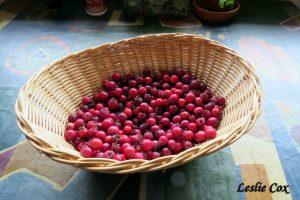 One good piece of information to note: serviceberries can be picked before they are fully ripe as they will finish ripening if laid out in newspaper-lined beer flats.
One good piece of information to note: serviceberries can be picked before they are fully ripe as they will finish ripening if laid out in newspaper-lined beer flats.
Royal Horticultural Society’s Award of Garden Merit 2012
Posted on October 20, 2021; updated on August 6, 2024
